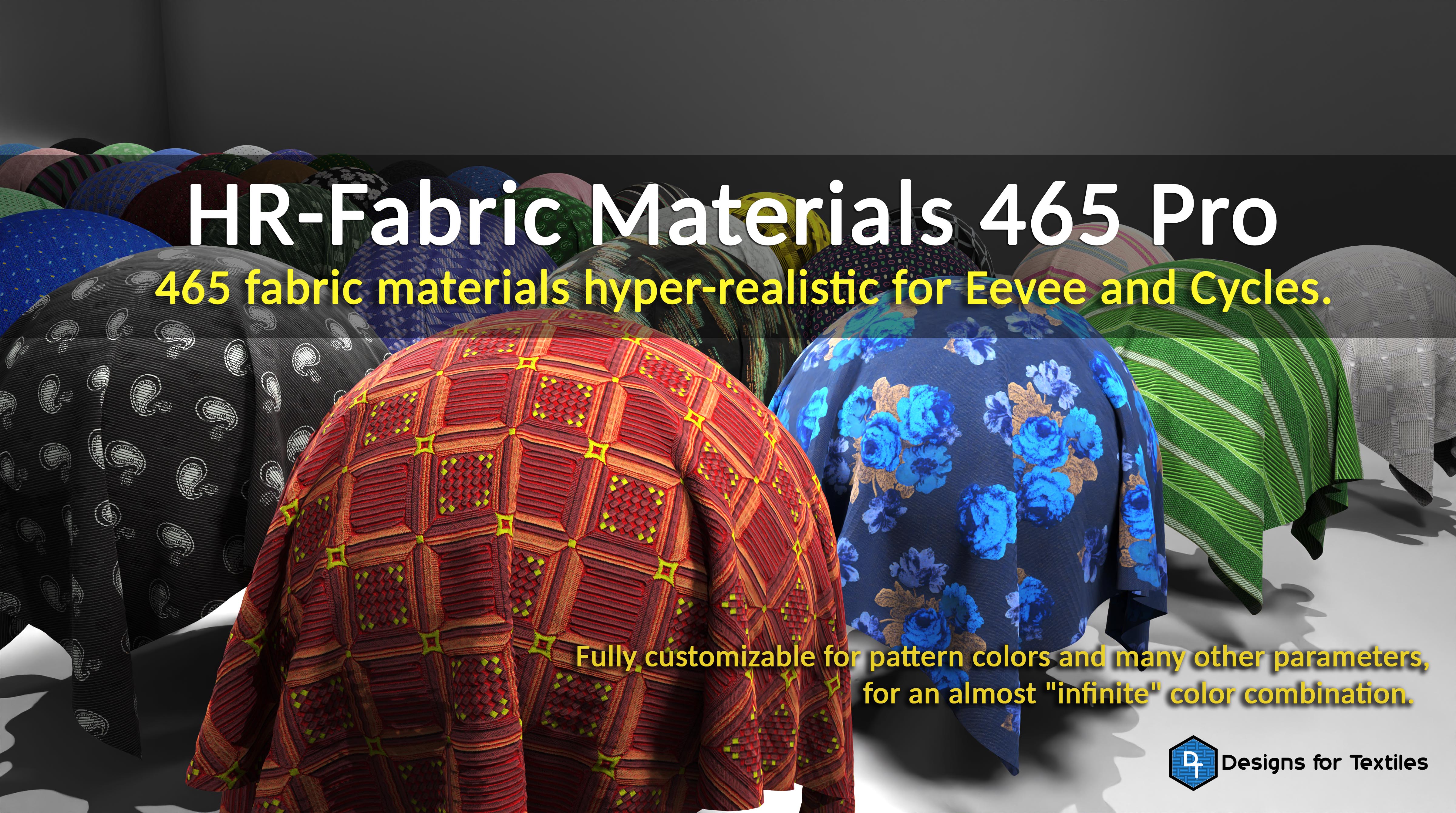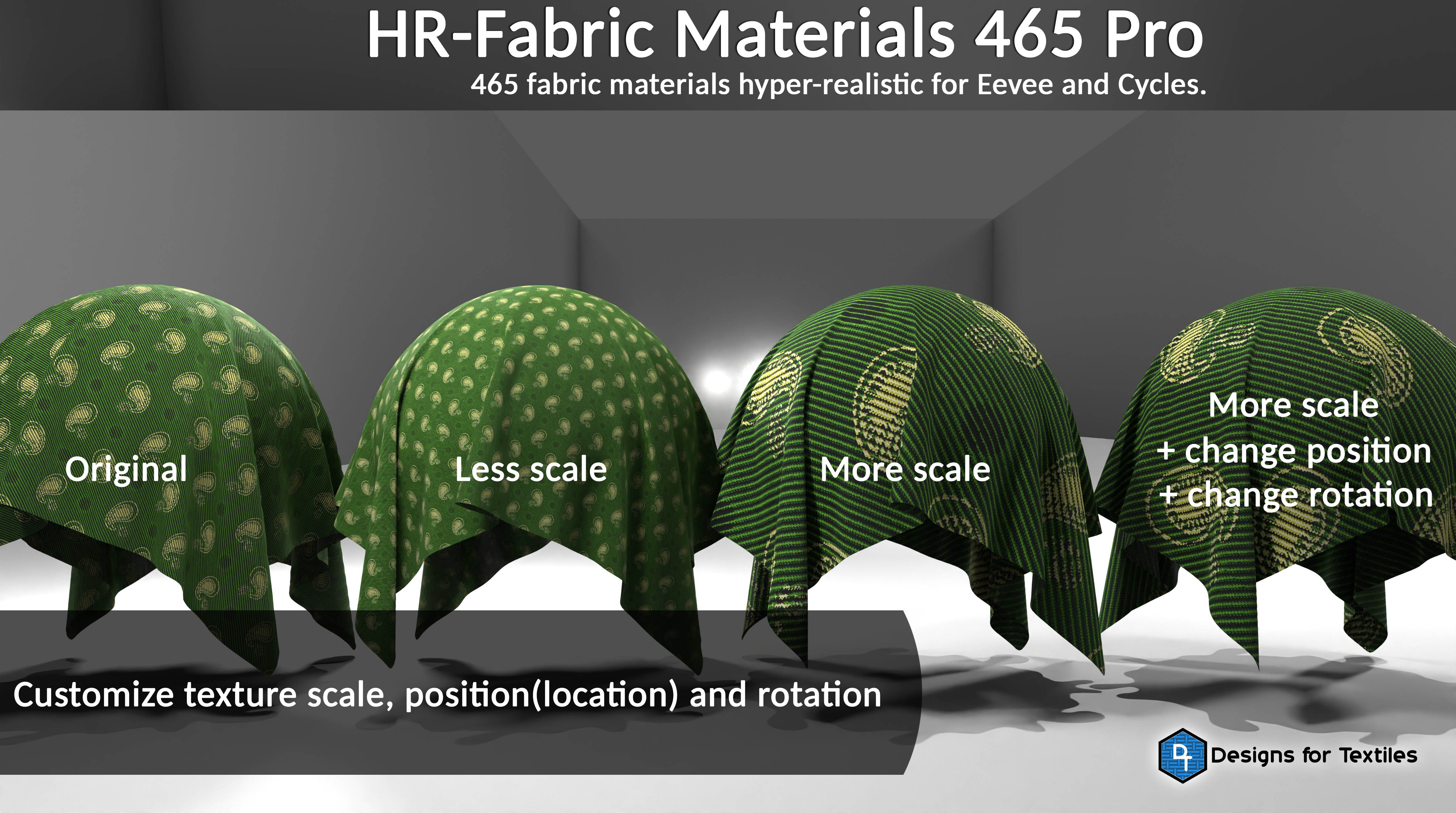Hr-Fabric Materials 465 Pro
Real and 3D professional fabric creations
NEW!
- July 2022 -
Finally ready the complete and detailed documentation for using the HR-Fabric Material 465 Pro textile materials package.
CLICK HERE
-------
HR-Fabric Materials v1.0
INTRODUCTION
HR-Fabric Materials 465 Pro is an hyper-realistic set of textile materials with great realism WITH 465 FABRIC MATERIALS, even in the micro details of the fabric. Thanks to the experience in the field of professional weaving of Designs For Textiles, was born this special package for all Blender users, at a price among other things really derisory compared to the large amount of materials, andthe quality of the result, and the technology used to make the materials. * Special price only for Blender Market and its members!
We are not faced with materials made with the classic system of scanning fabrics, but thanks to a technology of our realization, we create hyper-realistic fabrics from a 2D drawing as happens for the realization of real fabrics.
Now we make available to all Blender market users at the special price of 39 dollars, the ability to take advantage of many hyper-realistic fabrics pre-calculated, but customizable in many features.
* All textile materials aretaken from the collection of real fabrics, of our creation.

GENERAL FEATURES
HR-Fabric Materials 465 Pro, contains 465 fabric materials with different color variations and design type, such as flower patterns, geometric, patterned and more.
All master textures that make up the materials are in high resolution and range from 1K to 8K, depending on the type of design.
The textures while maintaining the logic of the power of 2, for total compatibility in every occasion, are not always square, to better fit the design of the real fabric from which they are taken, there are texutre that are 2048x2048, or 4094x8192, and many other combinations.
The number and type of different materials of fabrics allows use for most needs and purposes, such as making clothes, cushions, curtains, carpets, scarves, sofas, and any other application of fabrics, as it happens in reality.
Since each pattern of each material has different dimensions, don't be confused by the value of the texture resolution, because the 1K textures are already very high resolution because the size of the patterns that make up the 1K fabric are small, and don't need more pixels (which would be a waste of memory), for a high definition result.
So we can say that all of our materials render visually at the 8K level, even when they are at 1K.
However in order to have the best visual results also of the micro details, with high zoom levels of the camera, we suggest to use scenes with a resolution (if 16:9) of 3840x2160 pixels. In case you don't need to have particular close-up shots it is more than enough a resolution of 1920x1080 to have excellent results.
*Every material is already perfectly set up for the Eeeve and Cycles rendering engine.
CUSTOMIZATION
Each material is easily customizable in various characteristics. Each material is realized with different colors on the textile surface as it happens in the most refined and professional Jacquard textile creations (if you don't know what Jacquard weaving is and its particular characteristics click HERE).
COLORS
Each material is composedof various colors that can be modified independently, and each colorgenerally corresponds to a "micro" detail of the design.
Thanks to this mode ofcolor customization, "infinite" combinations of different colors are possible for each individual material.
Every single color ofevery material is customizable through shader control nodes with RGBwheel, brightness, contrast, saturation, hue and value.
It is also possible tomodify all colors simultaneously for brightness, contrast,saturation, hue and value.
AO MAP (Ambiente occlusion)
Each material is modifiable in the intensity of application of the AO map that allows you to change the micro shadows of the micro details of the surfaceof the various textile patterns.
All materials are already set for the best and most realistic visual rendering, but you can change the intensity at will for every need.
ROUGHNESS MAP
Each material is modifiable in the amount of fabric roughness based on a roughness map corrected for each material. Each material is already set for the best visual performance, but you can change the intensity as you wish for any need.
NORMAL MAP
Each material allows youto modify the intensity of the normal map to change the depth aspect precisely. Each material already has the normal map set for the bestr endering, which is however modifiable at will for every need.
DISPLACEMENT MAP
Each material also has a displacement map that allows you to increase or decrease the effectof the material's thickness and thickness curves.
This feature is only visible when using the Cycles rendering engine.
Also in this case the displacement map of each material has already been set to the best but it can be modified at will for every need, even to create special or unusual effects.
To maintain a high realismof the fabric we recommend NOT to use high values of displacement mapbut between 0 and 0.150 in the "scale" value, even if each material reacts differently to the values, so in some cases higher values may be good, in other cases less.
In this case you can experiment as you like with different values.
** Optional **
Even if there is no specific map, it is possible to modify the values of SUBSURFACE to create a more or less visible transparency effect for fabrics, useful for example in some cases for fabrics that let light shine through, such as certain types of curtains.
Texture POSITION (pattern)
Each material can be modified in the position of the drawing with the modification of the values in LOCATION for values of X,Y, Z.
Attention: the modification of the Z value works only if a modification of the rotation value (i.e. higher or lower than zero) of at least one of the X,Y, Z values is active.
Texture ROTATION (pattern)
Each material can be modified in the rotation of the design by modifying the values in ROTATION for values of X, Y, Z.
NOTE: the rotation in X and Y also allows a deformation of the design to realize in a few seconds different design effects, even very different ones.
The greater the value of the rotation, the greater the deformation.
Rotation in Z rotates on the texture axis without deformation. Therefore, to rotate the texture correctly you only need to use the Z value modification.
Texture SCALING (pattern)
Each material can be modified in the resizing of the design by modifying the SCALE values for X and Y values (there is no variation if the Z value is modified).
Note: to scale the design of the fabric/material proportionally it is necessary to insert equal values in X and Y, with different values the dimensions will logically change following only the chosen coordinate.
Fabric pattern DEFORMATION
Thanks to the change of the rotation values in X and Y and also thanks to the change of the texture scale in non-proportional mode, it is also possible to deform and modify the design of the material, thus being able to create new designs even very different from the original one.
This possibility adds even more customization possibilities to each material, recreating new design shapes using your imagination.
The deformation can be performed on any material even if it is recommended more on those fabrics that have geometric designs, fantasy, because other types of design, such as floral ones could give very strange results and perhaps not suitable for the characteristics of a design for fabrics.
COMPATIBILITY
HR-Fabric Materials 465 Pro was made for Blender 3.0 and higher versions, but is theoretically compatible with older versions that are not too old. However, we do not guarantee full compatibility with older versions of Blender.
CLASSIFICATION
Materials have been classified in a very convenient way using the new asset library for quick and easy searching.
Materials are classified into the following macro categories:
Bars - with designs with
bar effects, widely used in various textile fields, such as for ties,
scarves, furniture fabrics such as for pillows, sofas and others)
Fantasy - with designs of
type not easily definable, with figures of various types of fantasy.
(this is a type of fabric used for each use)
Floral - With designs with
mainly floral motifs.
Large Geometric - With
designs with geometric motifs of various types of medium/large sizes.
Paisley - With designs
with motifs of Paisley type (or also called Cashmere), very much used
in the weaving of more or less "oriental" ornaments. If you
don't know what Paisley patterns are click HERE to learn more.
Scottish - With Scottish
type designs, often used for shirts, skirts, scarves but also pillows
and other applications.
Small Geometric - With
more or less geometric type designs (but not only). The main feature
of this category concerns the "micro" design of the fabric
with very beautiful effects and really "infinite" designs,
usable for any type of textile application.
Squares - With designs having a structure with evident squared or rectangular characteristic both with small, medium and big dimensions.
SCENES
In the package there are 465 materials and 4 ready-made scenes with the correct lighting in order to try and see each material at its best. Each scene has a specific mesh to see the result on different types of applications and textile objects:
MASTER Scene
This scene is the main blender project where there are all the 465 materials divided for the various categories with a fabric on a sphere.
NOTE: we suggest to make a copy of the scene before doing tests and experiments, or NOT to save the scene on itself.
T-SHIRT Scene
In this scene we have a t-shirt made from two areas of fabric, the body part and the neck part, to test fabrics on this type of textile application.
(In this case the t-shirt is a static mesh and therefore the physics of the fabric is not applied)
PILLOWS Scene
In this scene we have 5 pillows arranged around and above a cube to test materials with appropriate lighting already in the scene. With this type of scene it is useful to evaluate how the effect looks on objects with curvilinear shapes.
(In this scene the meshes are static and therefore the physics of the fabric is not applied)
CURTAIN Scene
In this scene we have a
curtain to test how the materials appear on fabrics more or less free
as the curtains but firm at the top as it happens in the
curtains.
(In this scene the meshes are static and therefore the
physics of the fabric is not applied)
IMPORTANT TO KNOW
Only in the MASTER scene all the materials are available, in the other scenes only one material is available. To test the other materials you have to import them through the append in the scene/project you want from the MASTER project.
To make the append, you have to go to the file menu, click on append, go to the master project and then when the various folders appear, choose the one of the materials and choose which material you want to add to the chosen scene.
** To use the materials in a new project, you can use the append import technique as for the example scenes.
Discover more products like this
8k-textures fabric material 8k Hyper-realistic blender material 4k customizable photorealist 4k textures







